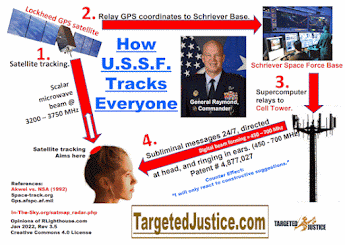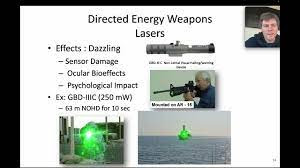Patent No. 5356368 Method of and apparatus for inducing desired states of consciousness
Patent No. 5356368
Method of and apparatus for inducing desired states of consciousness (Monroe, Oct 18, 1994)
Abstract
Improved methods and apparatus for entraining human brain patterns, employing frequency following response (FFR) techniques, facilitate attainment of desired states of consciousness. In one embodiment, a plurality of electroencephalogram (EEG) waveforms, characteristic of a given state of consciousness, are combined to yield an EEG waveform to which subjects may be susceptible more readily. In another embodiment, sleep patterns are reproduced based on observed brain patterns during portions of a sleep cycle; entrainment principles are applied to induce sleep. In yet another embodiment, entrainment principles are applied in the work environment, to induce and maintain a desired level of consciousness. A portable device also is described.
Notes:
CROSS-REFERENCE
TO RELATED APPLICATION
The present application is related to copending application No. 07/514,460,
filed Apr. 16, 1990 now U.S. Pat. No. 5,213,562.
BACKGROUND OF THE INVENTION
1. Field of the Invention
The present invention relates to an improved method of inducing desired states
of consciousness, including different levels of sleep, in human beings, using
a technique known as frequency following response (FFR), developed by the present
inventor. The invention also relates to apparatus for performing the method.
A number of areas of applicability of the invention are described, in accordance
with different preferred embodiments.
2. Description of the Background Art
In a prior patent, U.S. Pat. No. 3,884,218, the present inventor described a
method of inducing different levels of sleep, using the FFR technique, in which
brain waves could be made to follow superimposed frequency patterns. These frequency
patterns were provided as sine waves, at frequencies known to correspond to
different levels of sleep, such as alpha (exhibiting brain wave activity in
the range of 8-12 Hz), theta (6-8 Hz), and delta (1-4 Hz). EEGs exhibiting frequencies
between 12 and 30 Hz (known as a beta range) are characteristic of awake individuals,
though beta activity at even higher frequencies has been observed in different
types of mental activities. Gamma activity has been characterized as all activity
above 30 Hz; until recently, it has not been possible to monitor brain activity
in the gamma range. (It should be noted that the boundaries between gamma and
beta, beta and alpha, alpha and theta, and theta and delta are somewhat arbitrary;
the foregoing delineations are intended to be exemplary and not limiting.)
The present inventor discovered that the human brain could be entrained to output
brain wave patterns these different frequencies. While frequencies corresponding
to these different levels of sleep are not audible, by superimposing those frequencies
on some type of sound, such as music, it was determined to be possible to induce
desired levels of sleep. The individual listening to the music would "hear"
the low frequencies, with the desired effect on brain activity.
An improvement on the inventor's patented technique, to induce varied states
of alertness, is the subject of copending Application No. 07/514,460, the contents
of which are hereby incorporated herein by reference. This copending application
describes a general FFR technique using what is known as a binaural beat phenomenon,
details of which are provided in that application. Briefly, a binaural beat
is produced by sending signals at different frequencies (some Hz apart, depending
on the desired effect) to an individual's left and right ears. The difference
between the frequencies defines the frequency of the binaural beat. Using this
technique, the desired frequency can be introduced into the individual's brain
activity, inducing the desired state of consciousness.
The induction of FFR in the human brain in this manner results in the synchronization
of activity in the hemispheres of the brain. FIG. 1A shows brain activity without
FFR, and FIG. 1B shows brain activity with FFR. The inventor has coined the
term HEMI-SYNC (for Hemisphere Synchronization) to describe this phenomenon.
The copending application describes a technique wherein, in one form, sine waves
having a frequency corresponding to a consciousness state are superimposed on
two different carrier frequencies to form two different signals to set up the
binaural beat. In another form, an actual brain pattern, based on an electroencephalogram
(EEG) waveform indicative of that consciousness state is superimposed on the
different carrier frequencies to form two different signals. In use, each signal
is provided to one ear of a subject. The difference in carrier frequencies sets
up the binaural beat.
Another, more limited application of the binaural beat phenomenon is found in
U.S. Pat. No. 4,834,701. In contrast to the narrow range of frequencies discussed
in that patent, in the above-mentioned copending application, the applicability
of the binaural beat phenomenon is investigated over a much wider range of frequencies,
spanning the spectrum of brain activity.
Through additional investigation involving mapping of brain activities of different
individuals, the present inventor has discovered some significance to the fact
that, while brain waves at certain frequencies are characteristic of different
levels of sleep, brain patterns of different individuals still vary. The inventor
has investigated possible enhancements to the FFR effect by making it more generic
among individuals, yet still more specific to brain activity than a simple sine
wave, or an EEG of a particular individual.
Another area of investigation being performed by the present inventor relates
to human sleep patterns. Based on current knowledge of human sleep patterns,
it appears that sleep is composed of a series of 90-minute cycles. As stated
earlier, the beta stage is one of alertness. The first sleep state is alpha,
or mental and physical relaxation. The second is theta, or light sleep. Next
is delta, or deep sleep. The inventor has investigated the possibility of providing
FFR waveforms in cyclic patterns, replicating these human sleep patterns, to
facilitate sleep. Another possibility is to take advantage of the cyclic nature
of sleep patterns to provide a more gentle wake-up for a sleeper.
In considering the need for alertness during activities such as work, the inventor
also considered how it might be possible to introduce FFR waveforms into ambient
noise in one's surroundings to facilitate maintenance of desired states of consciousness.
Particularly in environments such as factories, or in offices where office equipment
puts out consistent types of noise, it would be desirable to be able to introduce
a binaural beat into that noise at different frequencies, to enhance the degree
of alertness of factory or office workers as desired.
SUMMARY
OF THE INVENTION
In view of the foregoing, according to one aspect of the invention, EEGs for
a number of individuals in different states of consciousness are sampled, and
EEG waveforms for the group of individuals, corresponding to each identifiable
state of consciousness, are combined. A binaural beat then is generated using
the combined EEGs.
According to this aspect of the invention, it has been determined that using
groups of EEG waveforms from different individuals and combining them to obtain
a representative waveform yields a waveform that a person's brain is more likely
to replicate than an individual EEG waveform, or a sine wave representation
of the EEG waveform. The combination may be simple averaging, though other combination
techniques, such as weighted averaging, for combining different numbers of EEG
waveforms as desired, are contemplated. Now that the inventor has discovered
that combinations of EEG waveforms provide a particularly effective entrainment
environment, it will be seen that various ways of combining these waveforms
may yield greater or lesser effects.
In accordance with another aspect of the invention, a method for replicating
cyclic sleep patterns for a desired sleep period is provided. In a preferred
embodiment according to this aspect of the invention, a subject is led from
beta, to alpha, to theta, to delta, then back to theta, then alpha, then a rapid-eye
movement (REM) or light dreaming sleep, in a sequence of 90-minute cycles, during
a sleep period of desired duration. After the expiration of the period, the
subject may wake up voluntarily. Alternatively, the invention can provide a
gentle external stimulus to lead the subject to a beta state.
With respect to this aspect of the invention, an apparatus is provided which
automatically leads an individual through these cyclic sleep patterns, and enables
the individual to set a desired sleep period. This device preferably takes advantage
of the techniques to be described relative to the first-mentioned aspect of
the invention, but is not so limited. The inventive contributions of this second
aspect of the invention are considered to lie in the combination of hardware
itself which generates the desired sequence of binaural beats, as opposed to
the particular software which determines the nature of those binaural beats.
In one form, the invention is constituted by an alarm clock which provides a
fade-in theta-alpha signal followed by a strong beta-gamma signal shortly before
a desired wake-up time.
According to yet another embodiment of the invention, selectable mind-affecting
sound patterns are provided to supplement constant ambient noise in any environment.
When the noise is not present, the patterns are not provided. The patterns vary
in amplitude in accordance with changes in the environmental noise.
In accordance with still another embodiment of the invention, a portable system
is provided to enable the wearer to introduce binaural beat signals of frequencies
that are selectable in accordance with a desired level of awareness. Depending
on the level of sophistication of the device, the binaural beat may be generated
using the combined EEG waveforms of the first aspect of the invention, but this
last aspect of the invention is not so limited.
-----------------------------------------------------------------------
While
the present invention has been described in detail with reference to preferred
embodiments, various modifications within the scope and spirit of the invention
will be apparent to those of working skill in this technological field. Consequently,
the invention should be considered as limited only by the scope of the appended
claims.




Comments